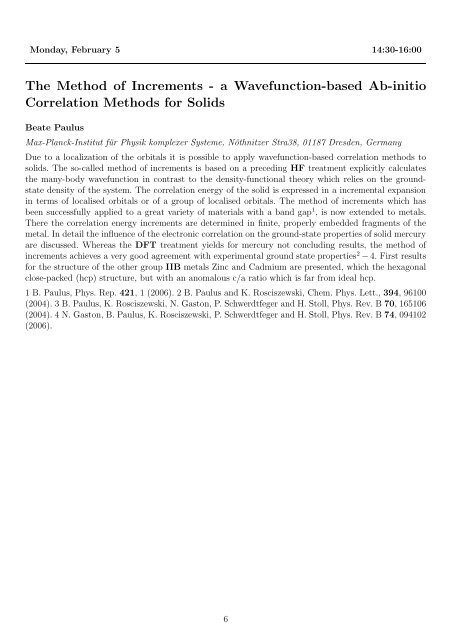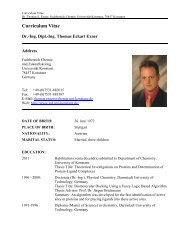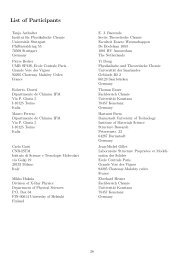The Role of the Lone Pairs in Hydrogen Bonding
The Role of the Lone Pairs in Hydrogen Bonding
The Role of the Lone Pairs in Hydrogen Bonding
Create successful ePaper yourself
Turn your PDF publications into a flip-book with our unique Google optimized e-Paper software.
Monday, February 5 14:30-16:00<br />
<strong>The</strong> Method <strong>of</strong> Increments - a Wavefunction-based Ab-<strong>in</strong>itio<br />
Correlation Methods for Solids<br />
Beate Paulus<br />
Max-Planck-Institut für Physik komplexer Systeme, Nöthnitzer Stra38, 01187 Dresden, Germany<br />
Due to a localization <strong>of</strong> <strong>the</strong> orbitals it is possible to apply wavefunction-based correlation methods to<br />
solids. <strong>The</strong> so-called method <strong>of</strong> <strong>in</strong>crements is based on a preced<strong>in</strong>g HF treatment explicitly calculates<br />
<strong>the</strong> many-body wavefunction <strong>in</strong> contrast to <strong>the</strong> density-functional <strong>the</strong>ory which relies on <strong>the</strong> groundstate<br />
density <strong>of</strong> <strong>the</strong> system. <strong>The</strong> correlation energy <strong>of</strong> <strong>the</strong> solid is expressed <strong>in</strong> a <strong>in</strong>cremental expansion<br />
<strong>in</strong> terms <strong>of</strong> localised orbitals or <strong>of</strong> a group <strong>of</strong> localised orbitals. <strong>The</strong> method <strong>of</strong> <strong>in</strong>crements which has<br />
been successfully applied to a great variety <strong>of</strong> materials with a band gap 1 , is now extended to metals.<br />
<strong>The</strong>re <strong>the</strong> correlation energy <strong>in</strong>crements are determ<strong>in</strong>ed <strong>in</strong> f<strong>in</strong>ite, properly embedded fragments <strong>of</strong> <strong>the</strong><br />
metal. In detail <strong>the</strong> <strong>in</strong>fluence <strong>of</strong> <strong>the</strong> electronic correlation on <strong>the</strong> ground-state properties <strong>of</strong> solid mercury<br />
are discussed. Whereas <strong>the</strong> DFT treatment yields for mercury not conclud<strong>in</strong>g results, <strong>the</strong> method <strong>of</strong><br />
<strong>in</strong>crements achieves a very good agreement with experimental ground state properties 2 − 4. First results<br />
for <strong>the</strong> structure <strong>of</strong> <strong>the</strong> o<strong>the</strong>r group IIB metals Z<strong>in</strong>c and Cadmium are presented, which <strong>the</strong> hexagonal<br />
close-packed (hcp) structure, but with an anomalous c/a ratio which is far from ideal hcp.<br />
1 B. Paulus, Phys. Rep. 421, 1 (2006). 2 B. Paulus and K. Rosciszewski, Chem. Phys. Lett., 394, 96100<br />
(2004). 3 B. Paulus, K. Rosciszewski, N. Gaston, P. Schwerdtfeger and H. Stoll, Phys. Rev. B 70, 165106<br />
(2004). 4 N. Gaston, B. Paulus, K. Rosciszewski, P. Schwerdtfeger and H. Stoll, Phys. Rev. B 74, 094102<br />
(2006).<br />
6






